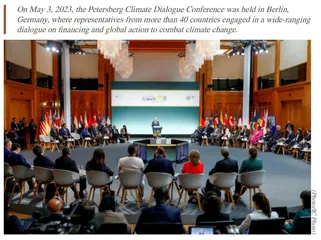Dilemmas and Prospects of the World Bank’s Climate Finance
作者: Zhu Jiejin

Currently, the World Bank is carrying out a new round of reforms for climate finance. In December 2022, the World Bank released the Evolutionary Roadmap (the Roadmap), in which the proposed climate finance reform program was introduced. In February 2023, then President Malpas, a climate change skeptic, announced that he was stepping down from his post, and Ajay Banga, a former advisor to the Climate Investment Funds (CIFs), was appointed as the new President of the World Bank, which again reflects the determination of the Word Bank to push forward the reform for climate finance. Against this backdrop, it is particularly important for the study of the future direction of development of multilateral development banks (MDBs) and the global economic governance system to look into and understand the World Bank’s new round of climate finance reform as well as the differences in the stances of the parties involved in the reform and the prospects for the reform.
Multilateral Development Banks and Climate Finance
The MDBs are tasked with the mission and obligation of addressing climate change, and are important actors in climate finance. The advantage of MDBs’ participation in climate finance is that most of the climate vulnerable countries that are susceptible to the impacts of climate change are also developing countries that are in urgent need of poverty eradication and shared prosperity. Over the years, the MDBs have been deeply engaged in project financing in developing countries, and are capable of providing these countries with the long-term financial and professional technical support needed for climate projects. In addition, combating climate change is also closely related to the development mission of the MDBs. In terms of project types, climate finance projects are mainly categorized into climate change mitigation (CCM) projects and climate change adaptation (CCA) projects. CCM projects focus on controlling greenhouse gas (GHG) emissions through energy transformation and increasing GHG absorption through afforestation and carbon sequestration. CCA projects focus on reducing the impacts of climate change by establishing early warning systems for extreme weather monitoring, strengthening climate risk management, building food reserves, managing water resources, etc. Due to the absence of a system to evaluate the effectiveness of CCA projects and the lack of recognition of the value of financial investment to CCA projects, most of the climate finance has gone to CCM projects and money for CCA projects is less in comparison.
Therefore, the MDBs have underscored extra attention to CCA projects while continuously increasing their climate financing efforts. At the 2019 UN Climate Action Summit, the MDB family pledged to scale up climate finance for low- and middle-income countries to $50 billion by 2025, including $18 billion for CCA projects. The World Bank has pledged that climate finance will account for 35 percent of its total funding by 2025, or to an annual average of $25 billion, with 50 percent of that funding going to CCA projects.
Generally, the MDBs have made some achievements in climate financing, but they are still far from providing the financial support needed to implement the Paris Agreement on climate change. The World Bank estimates that governments and the private sector in developing countries will need to spend an average of $2.4 trillion per year by 2030 to address climate change, conflicts or pandemics, accounting for about 6% of the total economic output of developing countries. More than 13 million people will be pushed into extreme poverty by 2040 as a result of the climate crisis. In the face of such a huge financing gap and the difficulties in fulfilling the Paris Agreement, the World Bank is actively pursuing climate finance reform to lead the MDB family as a whole to better undertake climate financing.
Divergent Stances in the World Bank’s Climate Finance Reform
At the end of 2022, the World Bank published the roadmap for climate finance reform, which centered on its mission, operating model, and financial capacity. It includes the following measures:
First, the World Bank will consider making sustainability as its third mission, adding to its dual mission of eradicating extreme poverty and realizing shared prosperity. By introducing the goal of sustainability, it hopes to define its responsibility and obligation to help countries cope with the climate crisis and contribute to the sustainability of the planet.
Second, it would improve capital utilization by optimizing its balance sheet. It plans to reduce its equity-to-loan ratio from 20% to 19%, which is expected to free up $4 billion annually for climate change mitigation and adaptation projects, accounting for 15% of its total annual lending. In addition, it will remove the project loan limit for a single borrowing country.
Third, a blended capital financing mechanism to better mobilize private capital for climate finance. The World Bank announced at its 2023 Spring Meetings that it will launch a pilot lending project for a blended capital of up to $1 billion to raise funds primarily from private investors in capital market, which is expected to mobilize $6 billion in climate finance.